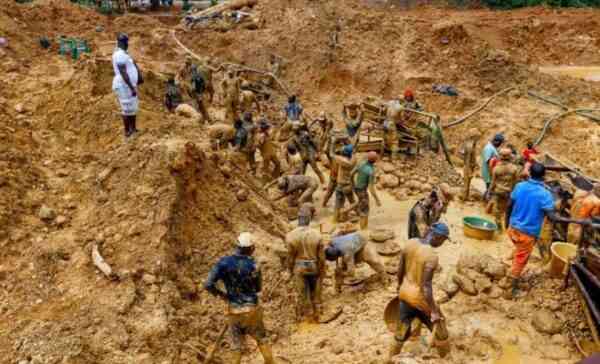
Illegal mining, often referred to as unregulated or artisanal mining, has become a pervasive issue in many regions of the world.
While it often stems from economic desperation and lack of formal opportunities, the environmental toll it exacts is severe and far-reaching.
The consequences of illegal mining are not limited to localised ecosystems but extend to the broader environment, threatening biodiversity, water resources, and human health.
This opinion analysis explores the environmental dangers posed by illegal mining and advocates for comprehensive strategies to address the crisis.
Deforestation and habitat destruction
One of the most visible and immediate impacts of illegal mining is deforestation. In mineral-rich regions, forests are often cleared to create access to mining sites.
In the Amazon rainforest, for instance, illegal gold mining has led to large-scale deforestation, threatening one of the planet’s most biodiverse ecosystems.
The removal of trees disrupts habitats for countless species, many of which are already endangered.
- Zvishavane villagers bemoan river siltation
- BCC, ZRP joint blitz nets 200 panners
- Gold panners target Nust
- How uncontrolled mining is decimating Zim’s environmental, socio-economic, and cultural heritage
Keep Reading
The destruction of habitats caused by illegal mining has cascading effects. Loss of vegetation leads to soil erosion, which in turn depletes the land’s fertility and disrupts local water cycles.
This process creates a feedback loop of environmental degradation, further reducing the ability of these ecosystems to recover naturally.
Water pollution and aquatic ecosystems
Illegal mining operations frequently involve the use of harmful chemicals, such as mercury and cyanide, to extract valuable minerals.
These toxic substances often find their way into nearby rivers and streams, contaminating water sources.
Mercury, in particular, is a major pollutant associated with illegal gold mining.
Once released into water bodies, mercury transforms into methylmercury, a highly toxic compound that accumulates in the food chain, affecting aquatic life and, ultimately, human populations.
Water pollution caused by illegal mining also disrupts aquatic ecosystems.
Sediment runoff from mining sites increases turbidity in rivers and streams, reducing sunlight penetration and impairing the growth of aquatic plants.
This, in turn, affects fish populations and other aquatic organisms that depend on these plants for food and shelter.
Soil degradation
Illegal mining practices often strip the topsoil, leaving the land barren and unsuitable for agricultural use.
The removal of soil layers during mining exposes subsoil and rocks, which are less fertile and more prone to erosion.
This form of land degradation has long-term consequences, as the recovery of topsoil is a slow process that can take decades.
In addition to physical degradation, illegal mining introduces toxic substances into the soil.
Chemical residues from mining operations leach into the ground, reducing soil quality and making it difficult for vegetation to grow.
This perpetuates a cycle of environmental damage, as the lack of vegetation exacerbates erosion and further depletes the land’s fertility.
Air pollution
Air pollution is another significant environmental danger associated with illegal mining.
Dust and particulate matter generated during excavation and transportation of minerals contribute to poor air quality.
In regions where illegal mining is rampant, communities often report increased respiratory issues, including asthma and bronchitis.
Moreover, the burning of mercury during gold processing releases toxic fumes into the atmosphere, posing a risk to both miners and nearby communities.
Prolonged exposure to these emissions can lead to neurological damage and other severe health conditions.
Biodiversity loss
The environmental impacts of illegal mining pose a direct threat to biodiversity.
The destruction of habitats, contamination of water sources, and degradation of land all contribute to the decline of plant and animal species.
Some species are unable to adapt to the rapid changes in their environment, leading to population declines and, in extreme cases, extinction.
Illegal mining operations often occur in areas that are home to unique and endangered species.
For instance, in the Democratic Republic of Congo, illegal mining for coltan and other minerals has disrupted the habitats of gorillas and other wildlife.
The loss of biodiversity in these regions has far-reaching implications, as it reduces the resilience of ecosystems and their ability to provide essential services, such as carbon sequestration and water purification.
Climate change implications
Illegal mining contributes to climate change in several ways.
Deforestation associated with mining reduces the ability of forests to act as carbon sinks, increasing the amount of carbon dioxide in the atmosphere.
Additionally, the burning of fossil fuels and other energy-intensive activities associated with illegal mining release greenhouse gases, further exacerbating global warming.
The environmental degradation caused by illegal mining also reduces the planet’s capacity to adapt to climate change.
For example, the destruction of wetlands, which act as natural buffers against floods, increases the vulnerability of communities to extreme weather events.
Human health risks
The environmental dangers of illegal mining extend to human health.
Contaminated water sources expose communities to toxic chemicals, leading to health issues such as kidney damage, neurological disorders, and developmental delays in children.
Similarly, air pollution from mining activities increases the risk of respiratory and cardiovascular diseases.
Illegal mining often occurs in marginalised communities where access to healthcare is limited.
This exacerbates the health impacts of environmental pollution, as affected populations are less likely to receive timely diagnosis and treatment.
Mitigation and solutions
Addressing the environmental dangers of illegal mining requires a multifaceted approach that combines regulation, community engagement, and international cooperation.
Strengthening enforcement and regulation
Governments must prioritise the enforcement of environmental laws and regulations to deter illegal mining activities.
This includes increasing funding for monitoring and enforcement agencies, as well as imposing stricter penalties for violations.
Promoting sustainable alternatives
Providing communities with sustainable livelihoods is crucial to reducing dependence on illegal mining.
Initiatives that promote eco-tourism, sustainable agriculture, and renewable energy projects can offer viable economic alternatives while preserving the environment.
Community education and awareness
Raising awareness about the environmental and health impacts of illegal mining is essential for fostering community support for conservation efforts.
Education campaigns can empower communities to demand better environmental practices and hold mining operators accountable
International collaboration
Illegal mining often involves transnational networks, making international cooperation essential.
Countries must work together to disrupt the supply chains of illegally mined minerals and implement certification schemes to ensure the traceability of raw materials.
Restoration and rehabilitation
Efforts to rehabilitate degraded lands and ecosystems affected by illegal mining should be prioritised.
Reforestation programmes, soil restoration initiatives, and the clean-up of contaminated water sources can help mitigate the environmental damage and promote ecosystem recovery.
Conclusion
Illegal mining is not just an environmental issue — it is a complex problem rooted in social and economic challenges.
However, its environmental dangers are undeniable and require immediate attention.
From deforestation and water pollution to biodiversity loss and climate change, the impacts of illegal mining are far-reaching and affect ecosystems and human populations alike.
To combat this issue, a coordinated and inclusive approach is essential.
Governments, communities, and international organisations must work together to address the root causes of illegal mining while mitigating its environmental impacts.
Only through collective action can we protect our planet and ensure a sustainable future for generations to come.
- Gary Gerald Mtombeni is a journalist based in Harare. He writes here in his own personal capacity. For feedback email garymtombeni@gmail.com/ call- +263778861608









